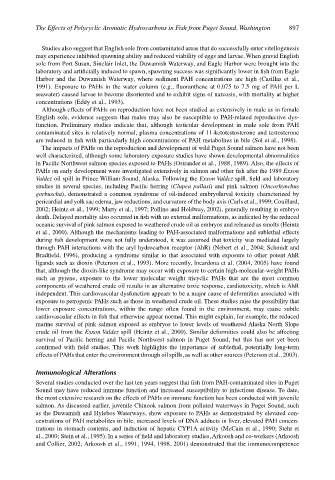Page 917 - The Toxicology of Fishes
P. 917
The Effects of Polycyclic Aromatic Hydrocarbons in Fish from Puget Sound, Washington 897
Studies also suggest that English sole from contaminated areas that do successfully enter vitellogenesis
may experience inhibited spawning ability and reduced viability of eggs and larvae. When gravid English
sole from Port Susan, Sinclair Inlet, the Duwamish Waterway, and Eagle Harbor were brought into the
laboratory and artificially induced to spawn, spawning success was significantly lower in fish from Eagle
Harbor and the Duwamish Waterway, where sediment PAH concentrations are high (Casillas et al.,
1991). Exposure to PAHs in the water column (e.g., fluoranthene at 0.075 to 7.5 mg of PAH per L
seawater) caused larvae to become disoriented and to exhibit signs of narcosis, with mortality at higher
concentrations (Eddy et al., 1993).
Although effects of PAHs on reproduction have not been studied as extensively in male as in female
English sole, evidence suggests that males may also be susceptible to PAH-related reproductive dys-
function. Preliminary studies indicate that, although testicular development in male sole from PAH
contaminated sites is relatively normal, plasma concentrations of 11-ketotestosterone and testosterone
are reduced in fish with particularly high concentrations of PAH metabolites in bile (Sol et al., 1998).
The impacts of PAHs on the reproduction and development of wild Puget Sound salmon have not been
well characterized, although some laboratory exposure studies have shown developmental abnormalities
in Pacific Northwest salmon species exposed to PAHs (Ostrander et al., 1988, 1989). Also, the effects of
PAHs on early development were investigated extensively in salmon and other fish after the 1989 Exxon
Valdez oil spill in Prince William Sound, Alaska. Following the Exxon Valdez spill, field and laboratory
studies in several species, including Pacific herring (Clupea pallasi) and pink salmon (Oncorhynchus
gorbuscha), demonstrated a common syndrome of oil-induced embryolarval toxicity characterized by
pericardial and yolk sac edema, jaw reductions, and curvature of the body axis (Carls et al., 1999; Couillard,
2002; Heintz et al., 1999; Marty et al., 1997; Pollino and Holdway, 2002), generally resulting in embryo
death. Delayed mortality also occurred in fish with no external malformations, as indicated by the reduced
oceanic survival of pink salmon exposed to weathered crude oil as embryos and released as smolts (Heintz
et al., 2000). Although the mechanisms leading to PAH-associated malformations and sublethal effects
during fish development were not fully understood, it was assumed that toxicity was mediated largely
through PAH interactions with the aryl hydrocarbon receptor (AhR) (Nebert et al., 2004; Schmidt and
Bradfield, 1996), producing a syndrome similar to that associated with exposure to other potent AhR
ligands such as dioxin (Peterson et al., 1993). More recently, Incardona et al. (2004, 2005) have found
that, although the dioxin-like syndrome may occur with exposure to certain high-molecular-weight PAHs
such as pyrene, exposure to the lower molecular weight tricyclic PAHs that are the most common
components of weathered crude oil results in an alternative toxic response, cardiotoxicity, which is AhR
independent. This cardiovascular dysfunction appears to be a major cause of deformities associated with
exposure to petrogenic PAHs such as those in weathered crude oil. These studies raise the possibility that
lower exposure concentrations, within the range often found in the environment, may cause subtle
cardiovascular effects in fish that otherwise appear normal. This might explain, for example, the reduced
marine survival of pink salmon exposed as embryos to lower levels of weathered Alaska North Slope
crude oil from the Exxon Valdez spill (Heintz et al., 2000). Similar deformities could also be affecting
survival of Pacific herring and Pacific Northwest salmon in Puget Sound, but this has not yet been
confirmed with field studies. This work highlights the importance of sublethal, potentially long-term
effects of PAHs that enter the environment through oil spills, as well as other sources (Peterson et al., 2003).
Immunological Alterations
Several studies conducted over the last ten years suggest that fish from PAH-contaminated sites in Puget
Sound may have reduced immune function and increased susceptibility to infectious disease. To date,
the most extensive research on the effects of PAHs on immune function has been conducted with juvenile
salmon. As discussed earlier, juvenile Chinook salmon from polluted waterways in Puget Sound, such
as the Duwamish and Hylebos Waterways, show exposure to PAHs as demonstrated by elevated con-
centrations of PAH metabolites in bile, increased levels of DNA adducts in liver, elevated PAH concen-
trations in stomach contents, and induction of hepatic CYP1A activity (McCain et al., 1990; Stehr et
al., 2000; Stein et al., 1995). In a series of field and laboratory studies, Arkoosh and co-workers (Arkoosh
and Collier, 2002; Arkoosh et al., 1991, 1994, 1998, 2001) demonstrated that the immunocompetence

